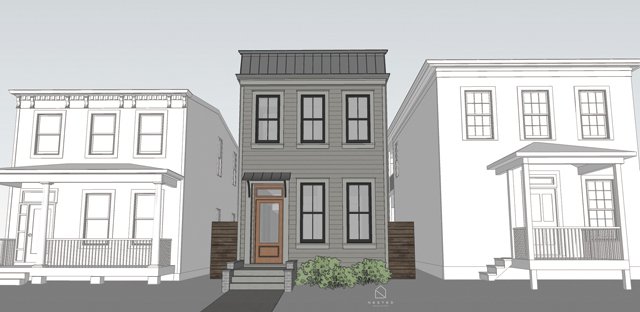RECENT COMMENTS
Eric S. Huffstutler on What is up with the Church Hill Post Office?
Eric S. Huffstutler on What is up with the Church Hill Post Office?
Yvette Cannon on What is up with the Church Hill Post Office?
crd on Power Outage on the Hill

“We put to CAR a design that was like a mullet”
05/18/2016 7:43 AM by John M
From the outset, we knew that our front facade and roofline would be the big issues since our rear facade is shielded from public view and thus out of the commission’s jurisdiction. CAR wants new construction to blend in, but it doesn’t want faux old designs that mimic historic homes. Likewise, it doesn’t want non sequiturs that undermine integrity and visual flow (see entry under “McMansion among row houses.”) With our architects, we put to CAR a design that was like a mullet: All business in the front and a party in the back. But, like the mullet, it failed. CAR sent us back to the drawing board to address issues with the roofline, front porch, basement and windows.
PREVIOUSLY:






Friends and neighbors, go straight to the source/regulating body for your information.
Learn about Richmond Old and Historic Districts at http://www.richmondgov.com/commissionarchitecturalreview/
There is a link to maps that will tell you if your home/building is in a Richmond Old and Historic District.
You can download the PDF Old & Historic Districts Handbook and Design Review Guidelines from that webpage, too.
The most tangible benefit of National & State Historic District designation is the availability of Rehabilitation Tax Credits for qualifying existing structures. To learn about that, go to:
Go to http://www.dhr.virginia.gov/tax_credits/tax_credit_faq.htm
Get the facts. Nothin but the facts.
Just a follow up on the previous post(s): State and National Historic Districts are not the same thing as city old and historic districts.
State tax credit: 25% Of rehab costs.
Federal tax credit: 20%
Usually, with the state and federal credit, the registers are both state and federal so the property is eligible for both. Someone else will have to chime in if it’s possible to only be eligible for one, and not the other, but if that’s the case it appears to be uncommon for that to happen. in any event the state and federal Historic Districts are different from the city old and historic districts.
The credits only apply to existing buildings that contribute to the district, not new construction. The city old and historic districts do not appear to confer any (direct) benefits, just restrictions, but perhaps someone else can speak to that? ( I am assuming that the city tax abatement program is available to everybody, regardless of district/area?)
I’ve done many a tax credit applications, with the state tax credits you can collect and sell the property the next day, you can move in and live there, you can rent it out. Now the federal tax credits are different, they are geared towards the investor , for commercial work, with federal credits you MUST rent out the property for a minimum of five (5) years. If your transferring (selling ) them to an investor then comes the LLC documents